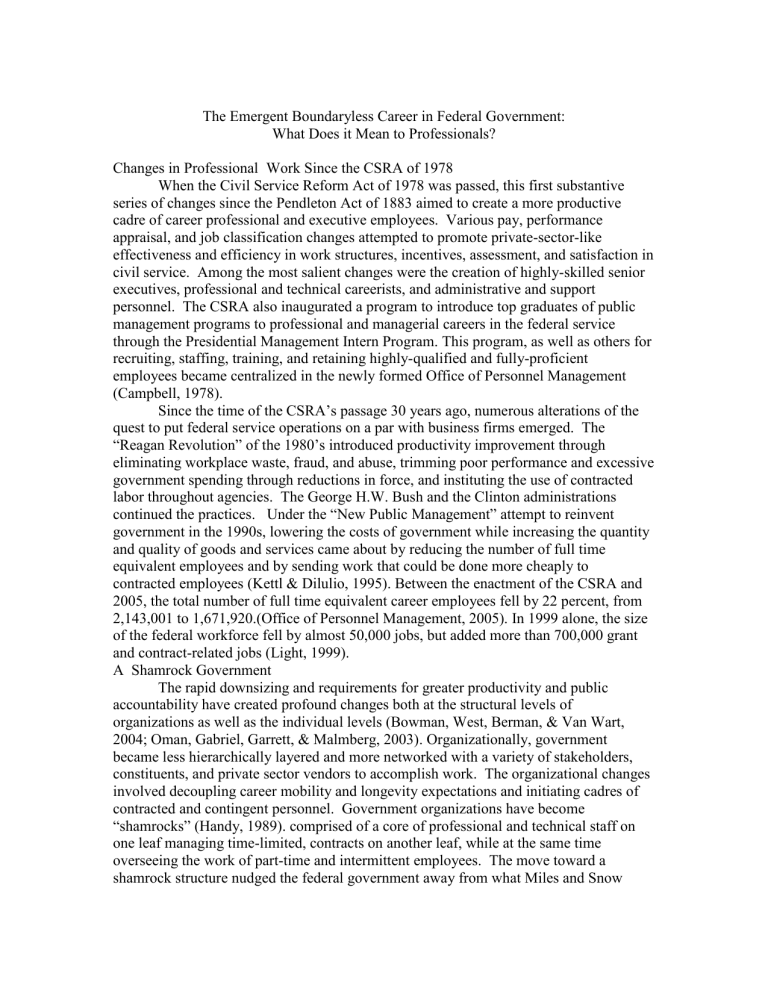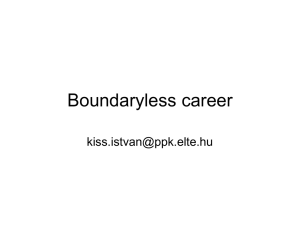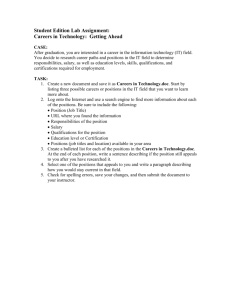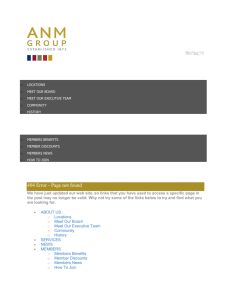Professionals' Perceptions of Careers Since the CSRA

The Emergent Boundaryless Career in Federal Government:
What Does it Mean to Professionals?
Changes in Professional Work Since the CSRA of 1978
When the Civil Service Reform Act of 1978 was passed, this first substantive series of changes since the Pendleton Act of 1883 aimed to create a more productive cadre of career professional and executive employees. Various pay, performance appraisal, and job classification changes attempted to promote private-sector-like effectiveness and efficiency in work structures, incentives, assessment, and satisfaction in civil service. Among the most salient changes were the creation of highly-skilled senior executives, professional and technical careerists, and administrative and support personnel. The CSRA also inaugurated a program to introduce top graduates of public management programs to professional and managerial careers in the federal service through the Presidential Management Intern Program. This program, as well as others for recruiting, staffing, training, and retaining highly-qualified and fully-proficient employees became centralized in the newly formed Office of Personnel Management
(Campbell, 1978).
Since the time of the CSRA’s passage 30 years ago, numerous alterations of the quest to put federal service operations on a par with business firms emerged. The
“Reagan Revolution” of the 1980’s introduced productivity improvement through eliminating workplace waste, fraud, and abuse, trimming poor performance and excessive government spending through reductions in force, and instituting the use of contracted labor throughout agencies. The George H.W. Bush and the Clinton administrations continued the practices. Under the “New Public Management” attempt to reinvent government in the 1990s, lowering the costs of government while increasing the quantity and quality of goods and services came about by reducing the number of full time equivalent employees and by sending work that could be done more cheaply to contracted employees (Kettl & Dilulio, 1995). Between the enactment of the CSRA and
2005, the total number of full time equivalent career employees fell by 22 percent, from
2,143,001 to 1,671,920.(Office of Personnel Management, 2005). In 1999 alone, the size of the federal workforce fell by almost 50,000 jobs, but added more than 700,000 grant and contract-related jobs (Light, 1999).
A Shamrock Government
The rapid downsizing and requirements for greater productivity and public accountability have created profound changes both at the structural levels of organizations as well as the individual levels (Bowman, West, Berman, & Van Wart,
2004; Oman, Gabriel, Garrett, & Malmberg, 2003). Organizationally, government became less hierarchically layered and more networked with a variety of stakeholders, constituents, and private sector vendors to accomplish work. The organizational changes involved decoupling career mobility and longevity expectations and initiating cadres of contracted and contingent personnel. Government organizations have become
“shamrocks” (Handy, 1989). comprised of a core of professional and technical staff on one leaf managing time-limited, contracts on another leaf, while at the same time overseeing the work of part-time and intermittent employees. The move toward a shamrock structure nudged the federal government away from what Miles and Snow
(1996) call traditional or “second wave” organizations and toward a more fluid, lessdecentralized “third wave” type. In the latter, professionals collaborate with multiple clientele to accomplish specific tasks or projects.
Who is a Professional?
Prolonged organizational and staffing changes have dramatically changed what has been traditionally defined as “professional” work. In the de-layering and networking, professionals awakened to a much different configuration of career paths and scopes. The
“traditional” view of careers which many had expected when they began working in the federal service was based on a mutual commitment of long-term service in exchange for stability, security, and prestige. Mosher (1982) depicts professional careers as anchored in identities established through long-term organizational affiliations. This organizationbased career consists of a large degree of specialized knowledge, autonomy of decision making and influence; governed by set of commonly-established ethical principles and practices; long term commitment to an employing organization, reflected in personal identification with mission and goals; and a high degree of specialized knowledge, which was bounded through shared values and beliefs, delimited fields of practice, and rigorous and progressively more specialized educational and credentialing requirements for entry and advancement.
Leicht & Fennel (1997): argue that changes in control structures and accountability have shifted normative regulation of work and work processes from collegiality to managerial oversight. Changes in organizational arrangements have exacerbated this shift. They note that professionals have moved from individual-centered practice to salaried employees in organizations. The authors add that professional practice in institutional settings has opened work up for not only peer assessment but also by levels of managers who have placed on professionals added demands for revenue generation and accountability. Professional work has increasingly become a product of not only professional employees, but also of contract employees working alongside them guided by management.
The Emergent Boundaryless Career in Government
In the wake of recent structural and staffing changes, professional careers have become less moored in specific organizations and more in collaborative work projects.
Increasingly, professional work in the federal service is becoming “boundaryless,” or less defined by individual professional expertise and more by collective repositories of knowledge (Bird, 1999). DeFillippi and Arthur (1995: 117-119) elaborate on the collaboratively-developed skills professionals require as “knowing why” (developing meaning from work); “knowing how” (honing career-skills and job knowledge); and
“knowing whom” (tapping and creating knowledge through networks or “communities of practice”.). Arthur and Rousseau (1996) describe boundaryless careers as having one or more common features: (a) careers that span several types of employment; (b) derive marketability through external contacts in networks; (c) provide opportunities for personal interests or meeting family responsibilities; and (d) are characterized by interdependent stakeholder ties rather than independent relationships.
Boundaryless careers also are characterized by increasing managerial or bureaucratic attempts at controls (Arthur, Khapova, & Wildersom, 2005), Those assigned responsibility for administrative control in work organizations also participate in professional projects which entail developing norms of autonomy and accountability;
these were once the acknowledged domain of professionals. The blurring of professional, managerial, and technical work boundaries requires the imposition of orderly authority to effect timely and efficient outcomes—further increasing managerial prerogatives.
Affects on Professional Careers
The profound changes in the federal government have altered professional careers. This can be substantiated through objective measurements in terms of employment numbers, output measurements, and even levels of commitment to mission and organization. But the observable effects of the changes give little idea of what the changes have meant to those who experienced them. Van Maanen (1977) points to the subjective dimensions of careers—values, aspirations, sense of identification—as being as important as objective assessments. Both objective and subjective elements of careers factor into individuals’ perceptions of meaning of a particular line of work as well as meaning to self. The objective career is often what others see; it is an individual performing a certain set of expected role behaviors in an official position ( Arthur,
Khapova, & Wildersom, 2005) . Subjective portions of careers may or may not be sharable. They often operate at subconscious levels of awareness, but influence how individuals respond to changes in status, life outside of work, security, and community.
The interdependence of objective and subjective career data allows individuals to interpret and make meaning of events as they are experienced (Weick, 1995).
The emergent phenomenon of boundaryless careers since the enactment of the
CSRA has not been explored from the standpoint of federal government professionals who have experienced them. Much of the existing research on changes in the federal government employment have focused on the effects of organizational and staffing shifts on performance improvement (Government Accountability Office, 2001); ethics of privitization in relation to values conflicts (Lawther,2004); structural arrangements and performance outcomes (Kettl & Dilulio, 1999; Light, 1999); effects of mission and accountability requirements on economic aspects of careers (Jewitt & Tirole, 1999) relationships between political and career employees; (Eisenberg, Ingraham &
Thompson, 1995; Dolan, 2000; Aberbach, 2003); the need for competency development
(Ingraham & Getha-Taylor, 2005; Bowman, West, Berman, & Van Wart, 2004); and
Hood & Lodge, 2004); values in the public sector (Stewart & Walsh, 1992) and the outcomes of the two Volker Commission Reports of 1989 and 2002 respectively (Lane,
Wolf, & Woodard, 2003). A few studies have been conducted of career meaning in non-
U.S. settings (Coyle-Shapiro & Kessler, 2002; Mallon, Duberley, & Cohen, 2000) and non-public organizations (Smith, 1997; Fuller, 2004; Eby, Butts & Lockwood, 2003; Peel
& Inkson, 2004; Heckscher, 1995; Rousseau, 1995; Guest, 2004; Granrose & Baccili,
2006; & Feldman, 2007). How professionals in the federal government have interpreted the changes in relation to the new, boundaryless careers has not been studied.
Purpose of the Study
To close the gap between objective and subjective elements of emergent boundaryless careers, this study will investigate the meaning of professional work among a selected sample of federal career professionals. The study will enable organizational leaders as well as human resource development researchers and policy makers to develop an understanding of professional careers from an emic, or participant-centered view
(Miles & Huberman, 1994).
Definitions and Assumptions
In this study, a “professional” career employee is defined as an individual who has spent a considerable length of time developing specialized expertise in a field of work that is delimited by educational credentials, standards of practice shared by participants in a particular community of knowledge, commitment to and identity with standards of practice, and identification with a particular organizational mission and goals. A central assumption is that development of expertise occurs through long-term association within an institutional context and as a result of interpersonal relationships among others who both share common beliefs and values about a field of knowledge and practice and who develop commitment to and identification with organizational purposes through expected rewards for performance. Accordingly, meaning of work rests, in part, on “psychological contracts” (Arthur & Rousseau, 1996) or interpersonal transactions between individuals and organizations. Meaning of work also occurs on an individual level through phenomenological interpretation (Husserl,1970; Polanyi & Prosch, 1975) and through collective “sensemaking” (Weick, 1995). It is also assumed that structural and staffing changes in organizations affect the meaning of professional individuals and that the meanings influence concomitant behaviors. Boundaryless careers, therefore, may be expected to alter meaning of professional work by their not being anchored to long-term organizational commitments (Arthur, Khapova, & Wildersom, 2005).
Research Questions
The emergent boundaryless careers, particularly in the public sector, entail new competency areas in addition to technical-professional skills and abilities. The truncated identification through long-linked transaction with an organization creates questions about the personal meaning of work. Moreover, participation in networked relationships, both inside and outside organizational boundaries, poses challenges for learning and remaining current in a particular line of professional work. Little is known, however, about how boundaryless careers are affecting the meaning of being a professional in the career civil service.
The study will answer the question, “How do federal career professionals interpret the phenomenon of the emergent boundaryless career in relation to the meaning of their work?” To answer this question, a series of related questions will be addressed: (a) How have perceptions of professional work in the federal government changed over time, given the advent of organizational re-structuring and the addition of contracted personnel performing professional work? (b) How do federal career professional employees define their roles qua professionals in particular organizations? (c) To what extent do professional career employees believe boundaryless careers contribute to professional growth in terms of expertise, satisfaction in government, and long-term affiliation with the organization?
Methodology
To develop an emic approach to understanding interpretation of boundaryless careers among professional employees, a case study research will be used. Case studies enable researchers to understand particular elements from gaining insight into individuals’ vantage points (Yin, 1994). The understanding is achieved through developing grounded theory (Glaser & Strauss, 1967) which describes relationships among subjective and objective elements of careers in particular organizational contexts.
The methodology is based on the belief that organizational contexts, situations, and individual interpretive apparatus are heuristic, yet share common constructs and themes
when observed across similar units of analysis (Miles & Huberman, 1994; Strauss &
Corbin, 1996). Hence, case study data will be collected and analyzed among professional individuals who vary in terms of age, ethnicity or race, and category of professional expertise.
Respondents will be selected based on analysis of organizational documents showing extensive downsizing over the last two or three decades and the employment of significant numbers of contract employees in professional areas of work. After initial organizational selection, the researcher will write the head of the agency explaining the purpose of the research, affirming confidentiality and anonymity of information, and requesting permission to interview, observe, and check non-confidential organizational documents regarding a sample of full time equivalent professional employees. Selection of respondents will be based on recommendations of the head of human resource offices of agencies and referrals of those nominated. The researcher will create a list of potential respondents, state the purposes of the study, assure confidentiality and anonymity of information, and seek their permission for a tape-recorded interview. Transcribed data will be kept in a locked box and then burned when the study is published. All names of individuals, their organizations, and possible personal identifiers will be changed.
To promote validity and reliability of data collected and analyzed, individual interviews will be tape recorded and transcribed, whenever possible, in employee offices or organizations. The researcher will use a computerized data collection and analysis tool, QSR NUD*IST, to permit economic use of time and enhance quality of coding.
Copies of findings will be given to respondents to check for accuracy and clarification of information (Creswell, 1994). Additionally, data will be collected and analyzed through triangulated methods of interviews, organizational document analysis, and respondent observations (Miles & Huberman, 1994).
Data will be collected and analyzed simultaneously and codes developed based on emergent categories or themes from the data (Spradley, 1979). The data will be compared with extant social science theory regarding professionals, career, and organizational change. From the constant comparison of data and relevant theory, (Miles
& Huberman, 1994) the researcher will construct a theoretical framework for answering the research questions. Data collection and analysis is expected to be completed within three months.
Limitations and Delimitations of the Study
Case study research has been criticized for the small number of respondents needed to achieve validity and reliability of results (Lincoln & Guba , 1985). However, in the study, the units of analysis are not respondents but rather incidents related to personal meaning. The range of these units will be sufficiently broad to allow for observation and analysis of variation. The range will be determined by the constant comparative method of analysis (Strauss & Corbin, 1994) to achieve data saturation
(Miles & Huberman, 1994).
The generalizability of case studies is limited to the specific time and context of data collection and analysis. This, however, is true of quantitative research studies
(Lincoln & Guba, 1985). To the extent that grounded theory can apply to organizations of similar characteristics, however, the findings may be applicable.
The research will be limited to organizations that have altered structural and personnel relationships significantly through downsizings, contracting, outsourcing, and
reductions in force over the last two or three decades. It will also be limited to career professionals who have experienced such events and who have remained in their organizations. These delimitations will be necessary in an exploratory study to assess the events in a “typical” organization-individual relationship during a particular time period.
Future research may examine those relationships that were not as common, such as those that did not have large attrition numbers or which did not employ large numbers of contracted, non-career professionals in performing work.
Data Analysis and Findings
Theoretical constructs of meaning of professional work since CSRA
Summary and Conclusions
Implications for Further Research, Policy and Practice
References
A, S., & Corbin, J. (1998). Basics of qualitative rresearch (2nd Edition ed.).
Thousand Oaks, CA: Sage.
Aberbach, J. D. (2003). The U.S.S federal executive in an era of change
Governance, 16 (3), 373-399.
Arthur, M., & Rousseau, D. (1996). The boundaryless career: A new employment principle for a new organizational era.
New York: Oxford University Press.
Arthur, M. B., Khapova, S. N., & Wilderom, C. (2005). Career success in a boundaryless career world. Journal of Organizational Behavior, 26 , 177-
202.
Bird, A. (1994). Careers as repositories of knowledge: A new perspective on boundaryless careers. Journal of Organizational Behavior, 15 (4), 325-344.
Bowman, J. S., West, J. P., Berman, E. M., & Van Wart, M. (2004). The professional edge: Competencies in public service.
Armonk, NY: :
M.E.Sharpe.
Campbell, A. K. (1978). Civil service reform: A new commitment. Public
Administration Review, 36 (2), 99-103.
Chapman, R. A. (1994). Change in the civil service. Public Administration, 72 (4),
599-610.
Coyle-Shapiro, J., & Kessler, I. (2002). Contingent and non-contingent working in local government: Contrasting psychological contracts. Public
Administration, 80 (1), 77-101.
Creswell, J. W. (1884). Research design: Qualitative and quantitative approaches . Thousand Oaks, CA: Sage.
DiFillippi, R. J., & Arthur, M. B. ( 1996). Boundaryless contexts and careers: A competency-based perspective . New York:: Oxford University Press.
Eby, L., Butts, M., & Lockwood, A. (2003
). Predictors of success in the era of the boundaryless career. Journal of
Organizational Behavior, 24 (6), 689.
Eisenberg, E. F., Ingraham, P. W., & Thompson, J. R. (1995). Political management strategies and political/career relationships: Where are we now in the federal government? Public Administration Review, 55 .
Feldman, D. C. (2007). Careers: Mobility, embeddedness, and success. Journal of Management, 33 (3), 350-377.
Fuller, S. (2004). Broken ladders or boundaryless careers? Job instability and worker well being.
Rutgers: The State University of New Jersey, New
Brunswick, NJ.
Glaser, B. G., & Strauss, A. L. (1967). The discovery of grounded theory:
Strategies for qualitative research . New York: Aldine de Gruyter.
Guest, D. (2004). Flexible employment contracts, the psychological contract and employee outcomes: An analysis and review of the evidence. International
Journal of Management Reviews, 5-6 (1), 1.
Hall, D. T. (1986). Career Development in Organizations . San Francisco: Joseey-
Bass.
Handy, C. (1989 ). The age of unreason.
Boston:: Harvard Business School
Press.
Hecksher, C. (1995). White collar blues: Management loyalties in an age of corporate restructuring . New York: Basic Books.
Hood, C., & Lodge, M. (2004). Competency, bureaucracy, and public management reform: A comparative analysis. Governance, 17 (3), 313-
333.
Husserl, E. (1970). The crisis of European sciences and transcendental phenomenology: An introduction to phenomenological philosophy (D.
Carr, Trans.). Evanston , IL: Northwestern University Press.
Ingraham, P. W., & Getha-Taylor, H. (2005). Common sense, competence, and talent in the public service in the USA: Finding the right mix in a complex world. Public Administration, 83 (4), 789-803.
Ingraham, P. W., Selden, S. C., & Moynihan, D. P. (2000). Influencing policy at the top of the federal bureaucracy: A comparison of career and political senior executives. Public Administration Review, 60 (1), 54-60.
Jewitt, I., & Tirole, J. (1999). The economics of career concerns, Part II:
Application to missions and accountability of government agencies.
Review of Economic Studies, 66 (1), 119-217.
Kettl, D. F., & Dilulio, J. J. (1995). Inside the reinvention machine: Appraising government reforms . Washington, D.C.: The Brookings Institution Press.
Lane, L. M., Wolf, J. F., & Woodard, C. (2003). Reassing the human resource crisis in the public service, 1987-2002. The American Review of Public
Administration, 33 (2), 123-145.
Lawther, W. C. (2004). Ethical challenges in privatizing government services.
Public Integrity, 5 (4
), 141-153.
Leicht, K. T., & Fennell, M. L. (1997). The changing organizational context of professional work. Annual Review of Sociology
23 , 119-217.
Lichtenstein, B., & Mendenhall, M. (2002). Non-linearity and response-ability:
Emergent order in 21st century careers. Human Relations, 55 (1), 5.
Light, P. C. (1999 ). The true size of government . Washington, DC: : The
Bookings Institution Press.
Mallon, M., Duberley, J., & Cohen, L. (2005). Careers in public sector science:
Orientations and implications. R&D Management, 35 (4), 395-407.
Miles, M. B., & Huberman, A. M. (1994). Qualitative data analysis: An expanded sourcebook (2nd Edition ed.). Thousand Oaks, CA: Sage.
Miles, R. E., & Snow, C. C. ( 1996.).
Twenty-first century careers.
New York::
Oxford University Press.
Mosher, F. C. (1978). Professions in public service. Public Administration
Review, 38 (2), 144.
Oman, R. C., Athanasaw, Y. A., Gabriel, R. L., Garrett, J. J., Godwin, N. D., &
Malmberg, K. B. (2003). A bibliography about a changed federal government workplace. International Journal of Public Administration,
26 (10 & 11), 1289-1302.
Peel, S., & Inkson, K. (2004). Contracting and careers: Choosing between self and organizational employment. Career Development International, 9 (6/7).
Polanyi, M., & Prosch, H. (1975). Meaning . Chicago: The University of Chicago
Press.
Polivka, A. E., & Nardone, T. (1989). On the definition of "contingent work".
Monthly Labor Review , 9-19.
Pringle, j. k., & Mallon, M. (2003). Challenges for the boundaryless career odessy. International Journal of Human Resource Management, 14 (5),
839-854.
Pringle, J. K., & Mallon, M. (2003). Challenges for the boundaryless career odyssey. The International Journal of Human Resource Management,
14 (5), 839-853.
Rousseau, D. M. (1995). Psychological Conracts in Organizations:
Understanding wirtten and unwritten agreements . Thousand Oaks, CA:
Sage.
Smith, V. (1997). New forms of work organization. Annual Review of Sociology,
23 , 315-339.
Spradley, J. P. (1979). The ethnographic interview . New York: Holt, Rinehart &
Winston.
Stewart, J., & Walsh, K. (1992). Change in the management of public services.
Public Administration, 70 (4), 499-518.
Van Maanen, J. (1977. ). Organizational careers: Some new perspectives . New
York: Wiley.
Weick, K. E. (1995). Sensemaking in organizations . Thousand Oaks, CA: Sage.
Yin, R. K. (1984). Case study research: Desisgn and Methods . Beverly Hills, CA:
Sage.






